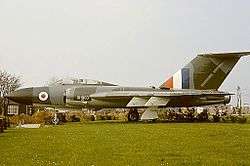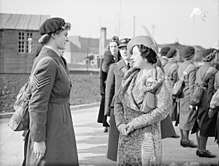RAF Innsworth
RAF Innsworth was a non flying Royal Air Force station, located on the north side of the city of Gloucester in England. The station closed in March 2008 and for the last 13 years of its life it was the headquarters of Personnel and Training Command. The site was transferred to the British Army and renamed Imjin Barracks becoming the home of the Allied Rapid Reaction Corps (ARRC) in 2010.
| RAF Innsworth | |
|---|---|
| Innsworth, Gloucester, Gloucestershire in England | |
 Gloster Javelin FAW9 'XH903' whilst on display during 1974 as RAF Innsworth's gate guardian. | |
 Multos sustentare (Latin for 'Home to many') | |
 RAF Innsworth Location in Gloucestershire | |
| Coordinates | 51°53′35″N 2°11′50″W |
| Type | Non-flying administrative, headquarters and support station |
| Area | 75 hectares[1] |
| Site information | |
| Owner | Ministry of Defence |
| Operator | Royal Air Force |
| Condition | Closed |
| Site history | |
| Built | 1940 |
| In use | 1940–2008 |
| Fate | Transferred to British Army and became Imjin Barracks. |
History
Second World War

The station opened in 1940, the first unit based there being No 7 School of Technical Training who trained engine and airframe fitters and mechanics. More than 2,000 officers and men were based at Innsworth by the time training began in earnest in 1941, this being delayed due to the arrival of 1500 RAF evacuees from Dunkirk.
In December 1941, No 2 WAAF Depot was opened at Innsworth and from then on the Station became increasingly associated with the Women's branch of the service. By the end of 1941 the strength of the Station had risen to more than 4,000 including trainees. Eventually it was decided to reserve the Station almost exclusively for WAAF training, including barrage balloon training amongst other vital roles.
Post-war
By the end of the war nearly 5,000 people were living on the Station, three quarters of them WAAF. It retained its training role, with the opening of No. 2 RAF School of Cookery in 1948. It was also the home to 33 RAF Regt Wing which deployed squadrons to emergencies in Cyprus and Northern Ireland. The station housed the Education Book Depot, which would have come in handy with both Nos. 7 & 13 Schools of Recruit Training. Innsworth was also the headquarters of No.4 Police District, and maintained a police presence up until very recently, when it was the HQ of PSS (WR).
In 1951 the Headquarters of the RAF Record Office which had been based nearby in Gloucester and Barnwood, moved to the station and gained Group status. Three years later in 1954 No. 5 Personnel Despatch Unit arrived, charged with the administration and processing of personnel selected for overseas service.
Just after the war ended the RAF Base Accounts Office moved from York to Gloucester and grew into the Central Pay Office and became part of the RAF Personnel and Training Command, which formed in 1994, based at Innsworth. Many other changes have taken place at Innsworth over recent years; these include the formation of Personnel Management Agency, contractorisation of the Station Support Services and the transfer of certain administrative functions (RAF pay and pensions) to the tri Service, Armed Forces Personnel Administration Agency (AFPAA), all in 1997. In March / April 2005 the MOD Medals Office and Joint Casualty and Compassionate Centre (JCCC) were established at Innsworth under AFPAA management.
The Station has always maintained a close association with the city of Gloucester, and on 7 April 1960, received the Honour of the Freedom of the City. The station has subsequently also received the freedoms of the Borough of Tewkesbury on 28 April 1977 and the Borough of Cheltenham in October 1986.
Closure
RAF drawdown
In 2005 it was announced that HQ Personnel and Training Command was to co-locate with HQ RAF Strike Command at RAF High Wycombe. The new collocated HQ's were subsequently merged to form Air Command and the decision was taken to close RAF Innsworth. The drawdown took place over the next three years with elements of the Personnel Management Agency moved to High Wycombe and RAF Cranwell and RAF Innsworth finally closed on 31 March 2008.
Transfer to British Army
Control of Innsworth was transferred to the British Army on 21 November 2008, when it was renamed Imjin Barracks. In 2010 the station also became home to the NATO Allied Rapid Reaction Corps (ARRC) which relocated to Innsworth from the Rheindahlen Military Complex in Germany.[2][3][4]
References
- "Defence Estates Development Plan (DEDP) 2009 - Annex A" (PDF). GOV.UK. Ministry of Defence. 3 July 2009. p. 43. Retrieved 7 May 2018.
- "The former RAF Innsworth site in Gloucestershire was officially renamed Imjin Barracks at a special ceremony on Friday 21 November 2008". It was formerly known as RAF Innsworth.(Farewell Innsworth, welcome Imjin, An Estate and Environment news article, 24 November 2008).
- "The fanfare of ownership and naming has subsided and the real business of making a home for ARRC begins in a material way" (Work begins at Imjin barracks, This is Glostershire, 14 February 2009)
- "In 2010, Imjin Barracks in Gloucester (formerly RAF Innsworth) will become home to the Allied Rapid Reaction Corps (ARRC) - a deployable NATO HQ relocating from Germany" (Defence in the South West, MOD, retrieved 2009-12-06)